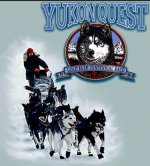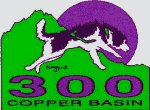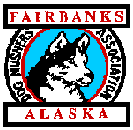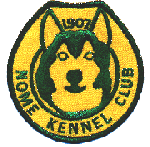Mushing
We've been involved with mushing
dogs for nearly ten years. After moving to Alaska, we moved into our house on
a Friday and the following Wednesday our first sled dog, Splinter, moved in.
From there, we collected several "throw aways" from another musher
we knew, and added our first real lead dog, Smokers. We wanted to raise our
own pups for our team, so we bred Splinter and from there, as dad says, "It's
all history."
Our dogs are as much a part of our
lives as we are of theirs. We've added an additional page
to show people how our dogs have impacted our lives.
 Dog
mushing is Alaska's state sport. Because of the type of terrain, and the lack
of forage foods like grasses, oats, etc., horses have never been used to any
great extent in the far north as draft animals. Dogs have always filled this
niche. No one really knows how far back humans started using dogs to help with
moving things from place to place. When gold was discovered in Alaska in the
1890s, Natives were using dogs to help make their lives easier. People headed
to the gold fields quickly adopted the use of dogs to pull sleds to haul their
gear. Authors like Jack London and Robert Service helped to spread the word
about dogs and dog teams.
Dog
mushing is Alaska's state sport. Because of the type of terrain, and the lack
of forage foods like grasses, oats, etc., horses have never been used to any
great extent in the far north as draft animals. Dogs have always filled this
niche. No one really knows how far back humans started using dogs to help with
moving things from place to place. When gold was discovered in Alaska in the
1890s, Natives were using dogs to help make their lives easier. People headed
to the gold fields quickly adopted the use of dogs to pull sleds to haul their
gear. Authors like Jack London and Robert Service helped to spread the word
about dogs and dog teams.
 Today
we celebrate the rich history of dog sports with races of various distances,
weight-pulling competitions, and other dog powered sports. Races are divided
into three categories, or types: sprint, mid-distance, and distance races. Perhaps
the best known of these is the Iditarod,
the 1049 mile race from Anchorage to Nome. We also have a second distance race,
the Yukon Quest, which
covers approximately 1100 miles between Fairbanks and Whitehorse, Yukon Territory.
Of the two, the Iditarod is better known, owing mostly to the extensive media
coverage it gets every year.
Today
we celebrate the rich history of dog sports with races of various distances,
weight-pulling competitions, and other dog powered sports. Races are divided
into three categories, or types: sprint, mid-distance, and distance races. Perhaps
the best known of these is the Iditarod,
the 1049 mile race from Anchorage to Nome. We also have a second distance race,
the Yukon Quest, which
covers approximately 1100 miles between Fairbanks and Whitehorse, Yukon Territory.
Of the two, the Iditarod is better known, owing mostly to the extensive media
coverage it gets every year.
 Mid-distance
races very in length from 150 to 300 miles and are generally run in 2 to four
days. Among these are the Copper Basin 300, the Klondike 200, and in 2000 a
new mid-distance race was started on the Kenai Peninsula called the Tustamena
200. Both the Iditarod and the Yukon Quest require that a musher planning to
run these longer races must enter and complete one or two mid-distance races
to ensure that they are aware of what to expect on the trail.
Mid-distance
races very in length from 150 to 300 miles and are generally run in 2 to four
days. Among these are the Copper Basin 300, the Klondike 200, and in 2000 a
new mid-distance race was started on the Kenai Peninsula called the Tustamena
200. Both the Iditarod and the Yukon Quest require that a musher planning to
run these longer races must enter and complete one or two mid-distance races
to ensure that they are aware of what to expect on the trail.
Sprint races reach about as wide
a range of mushers and team sizes as any dog-powered sport could. Beginning
with junior races cover distances of less than a mile and use teams of one dog
(if you can call a single dog a team). The kids who run these races can sometimes
be as young as five years old! Sprint races are divided up into categories depending
on the number of dogs in the team: one-dog, two-dog, three-dog, five-dog, and
seven-dog. The more experienced mushers compete in what is called an open class
where there is not a limit on the number of dogs in a team. One day I had the
experience of watching George Attla run a team of 24 dogs. It looked like a
fur covered freight train heading down the trail! The best known races in Alaska
are the Open
North American Championships in Fairbanks and the Anchorage Fur Rendezvous
World Championships held in Anchorage. These races bring mushers from all over
the world to compete.
 There
are a lot of sled dog and mushing associations throughout Alaska. Some are in
the major communities, some are in villages, some are made up of people from
a wider geographic area that are drawn together through their love of the sport.
Among these are the Alaska
Dog Mushers Association in Fairbanks, the Alaska Sled Dog Racing Association
in Anchorage, and the oldest one, the Nome Kennel Club in Nome. These associations
establish and maintain local trails and organize and sponsor various races throughout
the state.
There
are a lot of sled dog and mushing associations throughout Alaska. Some are in
the major communities, some are in villages, some are made up of people from
a wider geographic area that are drawn together through their love of the sport.
Among these are the Alaska
Dog Mushers Association in Fairbanks, the Alaska Sled Dog Racing Association
in Anchorage, and the oldest one, the Nome Kennel Club in Nome. These associations
establish and maintain local trails and organize and sponsor various races throughout
the state.
 For
folks who want to enjoy winter with their dogs and don't happen to have a whole
team of them, can try skijoring. It's an interesting sport that combines cross-country
skiing with dogs, and you don't have to have a northern breed dog to do it.
And you actually don't need so-called "northern breed" dogs to have
a team either. I once had a co-worker who's daughter wanted to learn to mush.
She has two yellow labs. It was sure funny watching those two dogs run down
the trail with their tongues hanging out and their big ears flopping up and
down! There are skijoring clubs in Fairbanks
and Anchorage that coordinate get togethers and races.
For
folks who want to enjoy winter with their dogs and don't happen to have a whole
team of them, can try skijoring. It's an interesting sport that combines cross-country
skiing with dogs, and you don't have to have a northern breed dog to do it.
And you actually don't need so-called "northern breed" dogs to have
a team either. I once had a co-worker who's daughter wanted to learn to mush.
She has two yellow labs. It was sure funny watching those two dogs run down
the trail with their tongues hanging out and their big ears flopping up and
down! There are skijoring clubs in Fairbanks
and Anchorage that coordinate get togethers and races.
There are a couple of good sources
for learning more about the sport of mushing and good, proper dog care. Mushing
Magazine is published in Ester, Alaska and draws upon expertise from all
aspects of dog-powered sports. Several years ago a group called Mush
with P.R.I.D.E. (Providing Responsible Information on a Dog's Environment)
was organized to help provide good information on dog care. Although intended
as a resource for mushers, they are also a great source for information for
anyone with a dog.

 Dog
mushing is Alaska's state sport. Because of the type of terrain, and the lack
of forage foods like grasses, oats, etc., horses have never been used to any
great extent in the far north as draft animals. Dogs have always filled this
niche. No one really knows how far back humans started using dogs to help with
moving things from place to place. When gold was discovered in Alaska in the
1890s, Natives were using dogs to help make their lives easier. People headed
to the gold fields quickly adopted the use of dogs to pull sleds to haul their
gear. Authors like Jack London and Robert Service helped to spread the word
about dogs and dog teams.
Dog
mushing is Alaska's state sport. Because of the type of terrain, and the lack
of forage foods like grasses, oats, etc., horses have never been used to any
great extent in the far north as draft animals. Dogs have always filled this
niche. No one really knows how far back humans started using dogs to help with
moving things from place to place. When gold was discovered in Alaska in the
1890s, Natives were using dogs to help make their lives easier. People headed
to the gold fields quickly adopted the use of dogs to pull sleds to haul their
gear. Authors like Jack London and Robert Service helped to spread the word
about dogs and dog teams. Today
we celebrate the rich history of dog sports with races of various distances,
weight-pulling competitions, and other dog powered sports. Races are divided
into three categories, or types: sprint, mid-distance, and distance races. Perhaps
the best known of these is the
Today
we celebrate the rich history of dog sports with races of various distances,
weight-pulling competitions, and other dog powered sports. Races are divided
into three categories, or types: sprint, mid-distance, and distance races. Perhaps
the best known of these is the  Mid-distance
races very in length from 150 to 300 miles and are generally run in 2 to four
days. Among these are the Copper Basin 300, the Klondike 200, and in 2000 a
new mid-distance race was started on the Kenai Peninsula called the Tustamena
200. Both the Iditarod and the Yukon Quest require that a musher planning to
run these longer races must enter and complete one or two mid-distance races
to ensure that they are aware of what to expect on the trail.
Mid-distance
races very in length from 150 to 300 miles and are generally run in 2 to four
days. Among these are the Copper Basin 300, the Klondike 200, and in 2000 a
new mid-distance race was started on the Kenai Peninsula called the Tustamena
200. Both the Iditarod and the Yukon Quest require that a musher planning to
run these longer races must enter and complete one or two mid-distance races
to ensure that they are aware of what to expect on the trail. There
are a lot of sled dog and mushing associations throughout Alaska. Some are in
the major communities, some are in villages, some are made up of people from
a wider geographic area that are drawn together through their love of the sport.
Among these are the
There
are a lot of sled dog and mushing associations throughout Alaska. Some are in
the major communities, some are in villages, some are made up of people from
a wider geographic area that are drawn together through their love of the sport.
Among these are the 